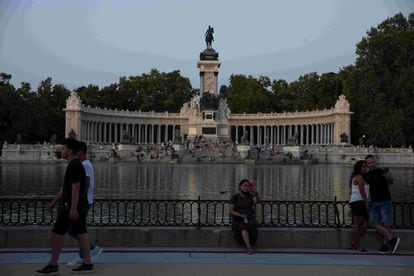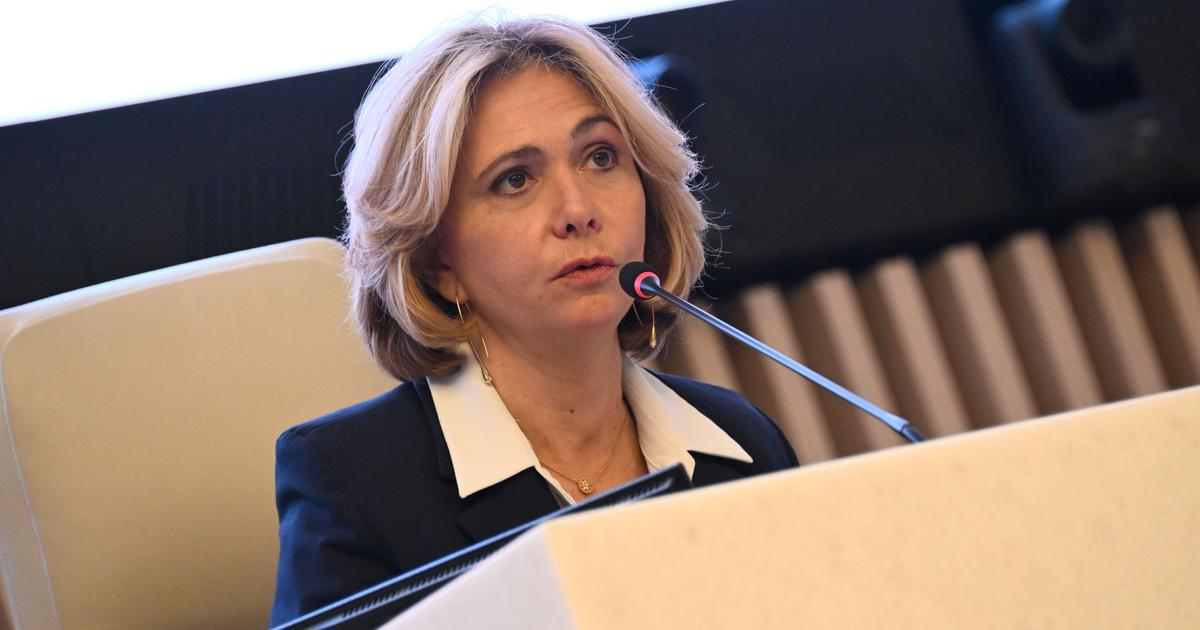The breeze still sways the leafy tops of the trees that guard the Paseo del Prado in the early hours of the morning.
Athletes run at a good pace before the heat sets in, and early riser couples enjoy, holding hands, a break from the cars after the pedestrianization of the avenue on weekends.
The first tree-lined walk in Europe, and the first in the world for public use, will get, hours later, to enter the Unesco World Heritage list this Sunday.
A victory that is celebrated with fireworks from the City Hall and with the lighting of the facade of the Royal Post Office, and that has behind an extensive dossier of about 1,500 pages that has managed to convince of the uniqueness of this natural urban landscape that the Madrid residents have chosen for five centuries as their place of leisure and recreation, combining the best of culture and science.
Views of the Landscape of Light, which encompasses the Paseo del Pardo and the Retiro, and which is included in the Unesco World Heritage list. Victor Sainz
Mónica Luengo, the coordinator of the Landscape of Light file, the name that the complex that encompasses the Paseo del Prado and the Retiro has received and that refers to the time of the Enlightenment, begins the tour of this enclave from Neptune, hours before that the final verdict of the commission is known.
She explains that municipal technicians, experts in mobility, urban planning, heritage or the environment have participated in the candidacy with specific help from historians, universities or the school of architecture, united in a common front that would value the exceptional of this area.
He emphasizes that they have not only had to explain the site and its history, but also how it will be preserved, the budget available and the response that will be given to the imminent challenge of climate change.
This must be ensured for future generations of all humanity.
It is now when the work begins
Mónica Luengo, coordinator of the file Landscape of Light
“The bottom line is that you have to ensure this for future generations of all humanity, you have to preserve it better than anyone else.
And that is what you are signing, it is now when the work begins.
In fact, the recommendation that they make us is to take care of the pavements of the Paseo del Prado, but it was decided not to get involved in construction work so as not to change what we had presented ”comments Luengo as he passed by a damaged sidewalk next to the Apollo fountain.
Actually, the Paseo del Prado had four monumental fountains: the Cibeles, Apolo, Neptuno and the Alcachofa. Luengo indicates that the latter is no longer here because it was transferred to the Retiro. With the reform of the 18th century it is the first time that they are used in series and in an allegorical way, and this landscape painter and art historian decides to tell the legend of Apollo, the god of arts and sciences, who represented the Bourbon monarchy and ruled the earth, which is Cybele, and the waters of Neptune. The Artichoke, symbol of fertility, ensured the continuity of the dynasty. There was a time when it was allowed to drink from these fountains, based on the drawings of Ventura Rodríguez, and in which different sculptors worked. "It is no longer possible," he laments,as she continues walking surrounded by pets that sniff the sidewalks and the gentle pedaling of bicycles.
The Retiro pond in Madrid, one of the enclaves that makes up the Landscape of Light.
Victor Sainz
If we look back, Madrilenians already walked this avenue in the 16th century.
Luengo stops to point out the length of the walk: "The Fuente Castellana stream passed through here and there were little bridges that allowed us to cross to the other side."
This was one of the few places where Madrilenians could socialize.
Later, at the level of the Naval Museum, the coordinator clarifies that the Retiro bordered the area, without there being a limit that separated both spaces.
It stretched from Alcalá to Atocha, in a unified landscape.
Felipe II decides to fix it and studies the location of the trees, plants rose bushes and makes ordinances to take care of them. There was even the Juan Fernández tower that welcomed the musicians to play and liven up the walk. He also wanted his wife, Ana de Austria, to see this driveway to the city, which is now overflowing with families who take advantage of the shade of the banana trees to avoid the high temperatures of July.
A century later, Felipe IV arrived, called the Planet King. “He was not a very good ruler, but he was the largest art collector in Europe and bought many collections. It coincides with the Golden Age of Lope de Vega, Calderón and Tirso de Molina, and makes a theater in the Palacio del Buen Retiro where these works premiered. They bring in an Italian set designer who would raise the back of the stage and see the gardens so that they could be incorporated into the show ”, summarizes Luengo with passion, trying to weave the history of the Landscape of Light, and describing details such as the naumaquias, representations of naval combat in the large pond of the Retiro, which had a small island in the middle that was used to recreate classics such as
Ulises
.
In addition, Luengo runs his finger along the left bank of the promenade, where palaces, such as the Thyssen, Buenavista and the great houses of the Medinaceli, begin to rise.
The logical thing would have been that these new constructions had been erected in the streets adjacent to the Palacio de Oriente, but no one wanted to miss the bustle of this area through which life passed, says Luengo.
The monument to the fallen ones.
SANTI BURGOS
Although it will be Carlos III in the 18th century who is in charge of the great sewage system. So it not only beautifies the city, it also cleanses it. It is at this stage when the true revolution of the concept of the public begins, and where Madrid becomes an enlightened city. “He makes the great reform and the Botanical Garden is brought in, where open classes were given and medicinal herbs were distributed. It has one of the largest collection of plates and scientific information in the world. The Spanish expeditions are the first to discover quinine, which was vital to reduce malaria fever, ”explains Luengo.
Also the Cabinet of Natural History, the Astronomical Observatory and the Academy of Sciences, which is the Prado Museum, and a public library at street level for people to enter and encourage them to learn, continues the historian, without hiding her admiration for a fact that did not occur in other European capitals, such as Paris or Berlin, which had tree-lined promenades but only intended for the nobility. Madrid, on the other hand, allowed the Landscape of Light to be a space by and for Madrilenians, open to any social class, in a democratic gesture that served as inspiration for the world.
The Alameda de Hércules, in Seville, a port that served as an exchange with the Americas, is a copy of the one in Madrid and this is how this model extends not only throughout the national territory, but also through Mexico City, Peru or Cuba, where they become the first public parks of the New Continent.
In addition, little by little the rest of the institutions come to settle in the vicinity of the Paseo del Prado and the Retiro, as if this urban landscape were magnetic. Luengo recapitulates and enumerates them: “The political power with the Congress, the economic power, with the Bank of Spain, the Church, the Army, the General Hospital, the Atocha station, the Museum of Decorative Arts, the Royal Spanish Academy and all kinds of institutions that represent a democratic society proliferate ”. Even the most luxurious hotels, such as the Ritz and the Palace, choose this location, and if we continue to open the range we could include La Casa Encendida, La Tabacalera and El Matadero, adds Luengo with his eyes fixed on the distance. Each thing has been fitting in an almost magical way.
The Unesco World Heritage candidacy for Prado and El Retiro enters the final stretch
The coordinator of the file recognizes how complex it has been to describe the 500 years of history, and confesses that they were afraid of not having explained well enough the intangible heritage that this landscape implies.
The recommendation of the International Council of Monuments and Sites considered that the Paseo del Prado and the Retiro were two separate properties, but Luengo and his team wanted to fight to the end to demonstrate that unique symbiosis that provided feedback to the entire complex.
In the end they have succeeded.
“The moment you become a World Heritage Site, you are obliged to pass periodic examinations. Every five years you present the state of conservation of how the site is. Now it is easier to get sponsorships, national funds and even foreign institutions that take care of heritage ”, highlights Luengo, who cites the example of Liverpool, excluded from the World Heritage list because the committee said that urban developments in the English city had threatened the value of the waterfront, with the future Everton FC football stadium, something they considered a "serious deterioration" of the place.
The Paseo del Prado and the Retiro are also obliged to preserve the values and the essence that have made them worthy of this distinction, which will considerably increase tourism, and any changes that are made will have to be consulted with Unesco.
A way to shield this urban cultural landscape, the first registered in Europe.
Subscribe here
to our new newsletter about Madrid.



/cloudfront-eu-central-1.images.arcpublishing.com/prisa/UIZFXVDB3NESDGT7N7RF3W4XKM.jpg)
/cloudfront-eu-central-1.images.arcpublishing.com/prisa/FNKUWF5HMBCL7OE2PKC53LFWHU.jpg)


/cloudfront-eu-central-1.images.arcpublishing.com/prisa/V7IVCNSXOVEJNPND426WBWSWJE.jpg)







